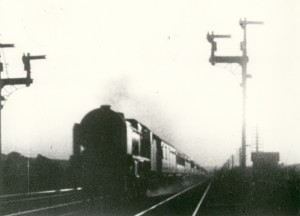Nearly eighty years after its release, Night Mail (Wright & Watt, 1936), produced by the General Post Office Film Unit, is still relevant to documentary filmmaking – its style, content and representation being key to the fundamentals of the non-fiction film. Night Mail follows the journey of the London, Midland & Scottish Railway postal service from London to Scotland, as it collects and delivers Britain’s mail.

Forsyth Hardy, film critic and John Grierson’s biographer, wrote in 1979 about the lasting appeal of the film in his book Grierson on Documentary – “Of all the hundreds of films which emerged from the documentary movement in the 1930s it has most surely stood the test of time.” Perhaps this is because the nostalgia evoked, was of a time in British culture that seemed untouched by modernity. Paradoxically however, the film proved to be stylistically and socially progressive. Modernist concepts such as commercial rebranding and details like expressionistic images – the beveled, clean lines of the titles, the specially commissioned music and poetic verse suggested a cultural shift.
Founded by Grierson in 1933, the G. P. O. Film Unit made documentaries to promote British industry to the British public. Films such as Granton Trawler (Grierson, 1934), about the fishing industry reminded the nation that respect and gratitude should be given to everyday workers. Referring to this concept Night Mail director Basil Wright said that the film was, “commissioned by the post office […] to explain to the Post Office workers how this particular aspect of the vast organization happened” (ref. Grierson Archive, GA.10.55). Grierson went on to say, “It was some satisfaction to take those letters G.P.O and make them stand for what was most progressive in the cinema” (ref. Grierson Archive, G3.14.5).
Night Mail’s appeal was partly due to the collaboration of modern disciplines and experimentation in sound and visual style. The combination of Grierson’s production, Cavalcanti’s sound direction, W.H.Auden’s poetic verse and music by composer Benjamin Britten constructed an almost avant-garde aesthetic. The juxtaposition between man and machine – the close-up shots of the moving pistons, the point of view shots from the engine drawing the audience in and the precise timing of the mail bag pick-up as postal workers listen to the beats of the wheels on the track – evokes a poetic artistry. Talking to the B.B.C about the pre-production, Grierson recounts the emotional connotations, “The train had become the living embodiment of a whole slice of British life” (ref. Grierson Archive, G7.23.3).

On its release, Night Mail was successful, in part due to transportable projection units. In Sight and Sound in 1937, J.B. Holmes, director of productions at the G.P.O discussed their method of distribution, “With machines, operators, screens and films, they were capable of showing in almost any sort of premises” (ref. Grierson Archive, G3.P4). Aside from the influential use of the cinematic device and the modernist propaganda ascribed to the film; far beyond the filmmaking world, railway enthusiasts have sustained the appeal of Night Mail and as a result, in 2013 a sculpted bust of Grierson was introduced to Stirling railway station.
(Susannah Ramsay, M. Litt. in Film Studies)